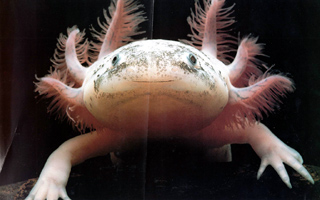Axolotls, I love those little guys.
Author: Milan
In the spring of 2005, I graduated from the University of British Columbia with a degree in International Relations and a general focus in the area of environmental politics. In the fall of 2005, I began reading for an M.Phil in IR at Wadham College, Oxford. Outside school, I am very interested in photography, writing, and the outdoors. I am writing this blog to keep in touch with friends and family around the world, provide a more personal view of graduate student life in Oxford, and pass on some lessons I've learned here. View all posts by Milan


That said, they do imperil my Klein Bottle:
“Acme’s unconditional guarantee has the condition that we do not warrant any Klein bottle against the actions of cats, ferrets, or axolotls.”
That looks like a science fiction creation, but sweet in a way.
Giant ice island breaks off Arctic shelf
An ice island the size of a small city is adrift in the Arctic after breaking free from one of Canada’s largest ice shelves, scientists said today.
The ice island is 37 metres (120ft) thick and measures 9 miles by 3 miles, according to the CanWest News Service. It broke clear from Ellesmere island, about 500 miles south of the North Pole, 16 months ago, triggering tremors so powerful they were picked up by earthquake monitors 155 miles away.
Scary stuff.
You can see the satellite photos here.
“Shall I compare thee to a prairie vole?
Thou art more faithful and monogamous.
Rough winds may blast thee, stress may take its toll
And botox leave thy brow impervious;
Sometime too hot the eye of heaven shines
And oft thy sun-cream UV rays lets through;
And every perfect pout at last declines
Into a wrinkled spouse’s sulking moue.
But our strong love shall not its power lose
While opioids keep us on the straight and narrow
While oxytocin does its magic prove
And vasopressin binds us one to other.
So long as men can keep their hormones potent
They’ll be romantic as that model rodent.”
Talks David Gallo: Underwater astonishments
Axolotl verges on wild extinction
Matt Walker
Editor, Earth News
The amphibian that never grew up is on the verge of going extinct in the wild.
New survey work suggests that fewer than 1,200 Mexican axolotls remain in its last stronghold, the Xochimilco area of central Mexico.
The axolotl is a type of salamander that uniquely spends its whole life in its larval form.
Its odd lifestyle, features and ability to regenerate body parts make it a popular animal kept in labs, schools and as pets.
But in the wild, the future is bleak for this “Peter Pan” of animals.
[I]n 1998 there were thought to be around 6,000 axolotls per square kilometre of the Xochimilco.
By 2004 just 1,000 lived in the equivalent area, and by 2008 around 100 animals survived per square kilometre, Dr Luis Zambrano and colleagues at the National Autonomous University of Mexico, based in Mexico City report in the journal Biological Conservation.
That is a ten-fold reduction in four years and a 60-fold reduction in ten years, leading the International Union for Conservation of Nature to classify the species as endangered on its annual Red List of threatened species.
Now “our best estimates using unpublished data, but with two different techniques, sampling and genetic, suggests that the total amount of axolotls in the wild is between 700 and 1,200 animals,” says Dr Zambrano.
As with geckos, until they’re bred successfully in captivity, popularity as a pet is a losing survival strategy.
cf. the Fennec fox also.
The Axolotl Song
The Axolotl is the luckiest animal in all of Mexico, for he exhibits a property called neoteny, meaning that he reaches sexual maturity without undergoing metamorphosis. The axolotl can be induced to metamorphose by drinking salamander goo. Isn’t that BRILLIANT? We just HAD to write a song about it.